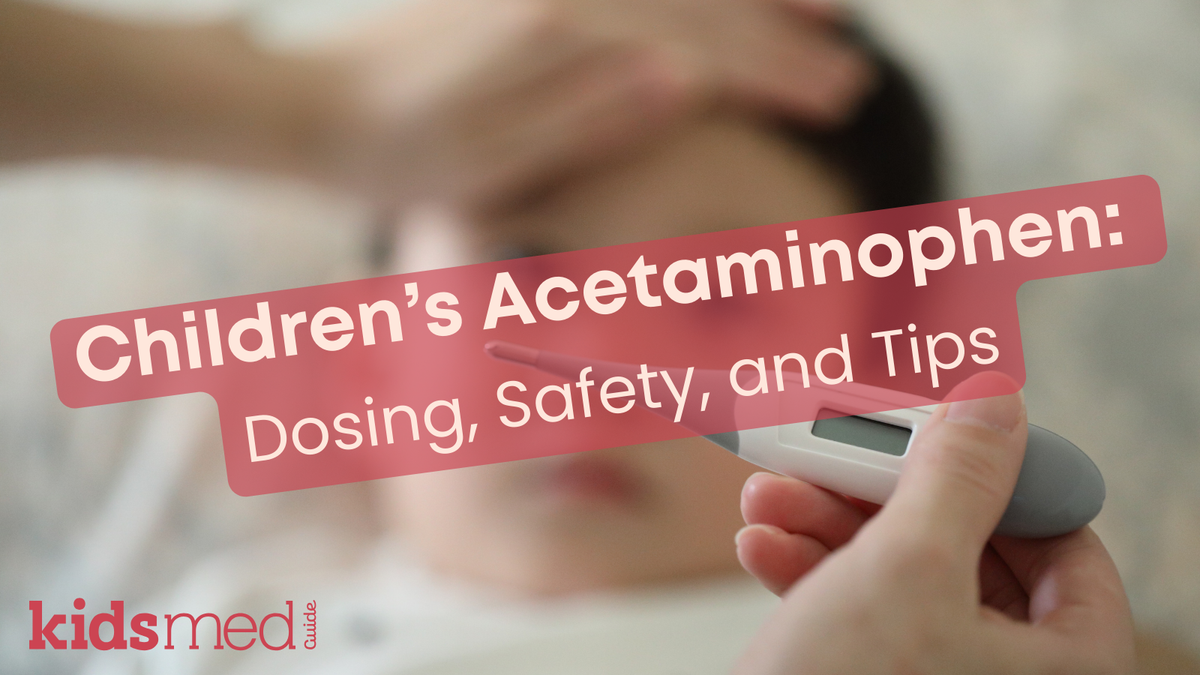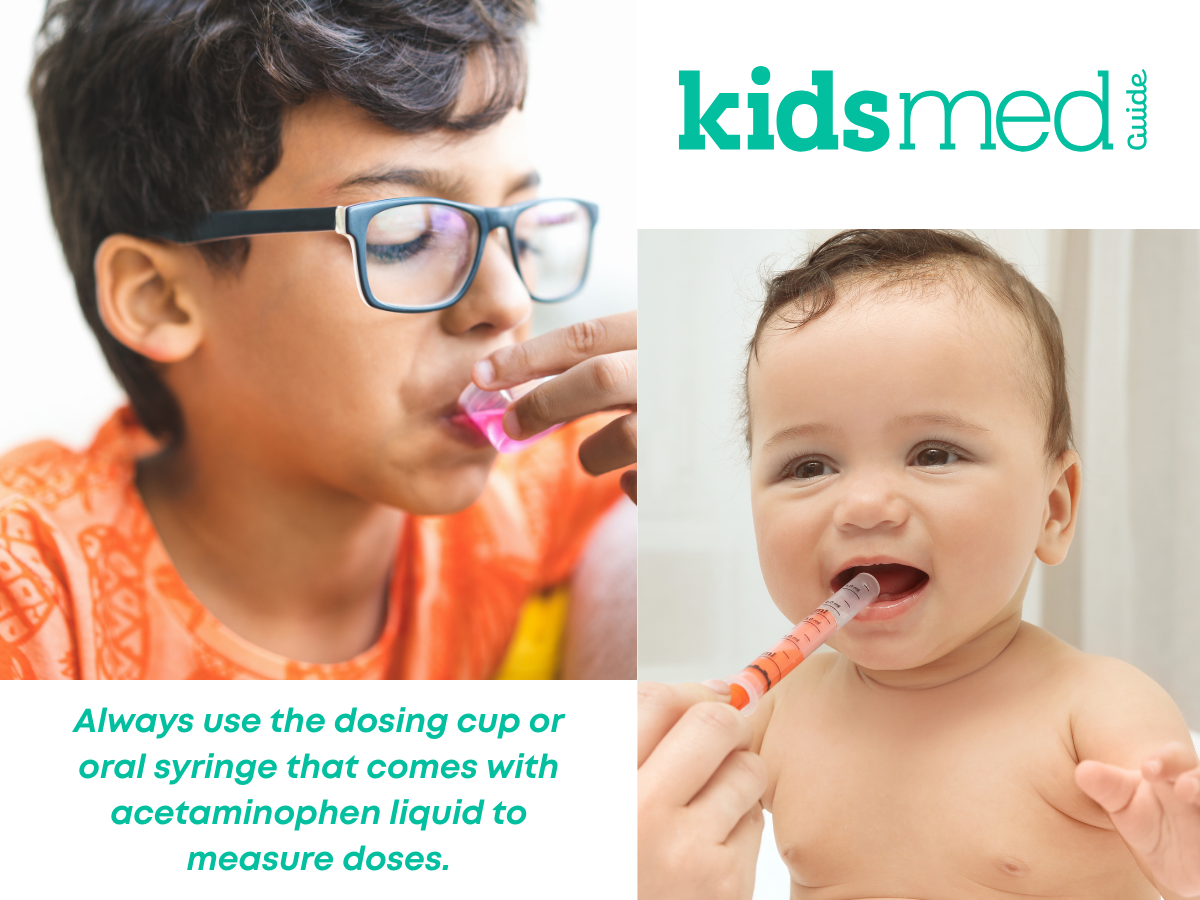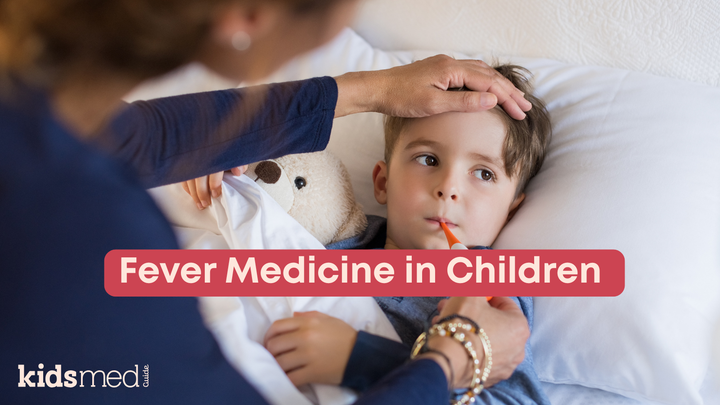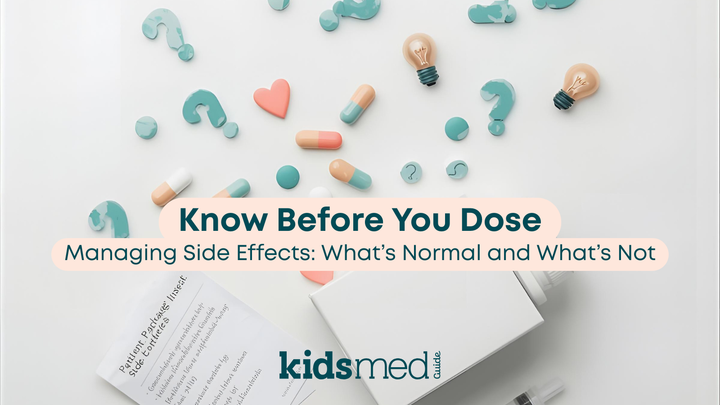Acetaminophen: A Parent’s Guide to Safe Fever & Pain Relief in Kids

Few situations are more stressful than your child developing a fever in the middle of the night! Acetaminophen (brand name Tylenol®) is one of the most trusted and widely used medicines for reducing fever and treating pain in children. It works effectively, is safe for most children when used properly, and is a must-have in every family’s medicine cabinet.
Read this guide for dosage and safety tips, as well as practical advice on managing pain and fever in kids!
What Is Acetaminophen?
Acetaminophen is both an analgesic (pain reliever) and an antipyretic (fever reducer). It works in the central nervous system to relieve pain and lower body temperature. Unlike ibuprofen, it does not reduce inflammation.
It is often recommended for pain and fever relief in children because it works well, is gentle on the stomach, and is safe for infants and children over 3 months old when appropriately used.
It can be purchased alone or in various combination products, such as cough and cold or flu medicines. Therefore, reading labels carefully and tracking doses are essential for safe use. We recommend not using combination cold medication in children.
When Is Acetaminophen Used in Kids?
Acetaminophen is appropriate for:
- Fever relief from colds, flu, ear infections, viral illnesses, and other infections, or after vaccinations
- Mild to moderate pain (headache, sore throat, teething, or minor injuries)
Pharmacist note: Not all fevers need medicine. Fever is often a normal and appropriate response to infection. If your child is comfortable and able to drink water, then fluids and rest may be enough!
Always call your pediatrician if your baby under 3 months has a fever. Do not self-treat a fever and notify your healthcare provider if your child is immunocompromised, has a central line or port, is on chemotherapy or other medications for transplant or cancer, or has certain disease conditions such as sickle cell disease.

Available Forms of Acetaminophen
Children’s acetaminophen comes in several formulations, making it an ideal choice for treating discomfort in all kids, even the most picky toddlers!
- Liquid suspension: 160 mg/5 mL (standard strength for all children’s products)
- Chewable tablets: 80 mg or 160 mg each
- Tablets/capsules: 325 mg or 500 mg (for older children and teens)
- Extended-release tablets: 650 mg (not recommended in young children)
- Suppositories: 80 mg, 120 mg, 325 mg, 650 mg
Parent-friendly tips
- Liquids come in different flavors, including dye-free and sugar-free options. Always use the dosing cup or oral syringe that comes with the product. Do not use a kitchen spoon.
- Chewables are helpful for children who resist liquids. Just double-check the strength per tablet and the dosing directions on the package, as two different options are available!
- Suppositories can be a lifesaver for vomiting children, children who are unable to take medication by mouth, or infants who refuse oral meds. These can be cut into halves or quarters for correct dosing — ask your pharmacist for guidance.
How to Dose Acetaminophen in Children
Properly dosing acetaminophen is very important. Taking too much can harm your child's liver, while underdosing won't provide the relief they need from fever or pain.
All acetaminophen products purchased over-the-counter should have a medication label with dosing directions. Always follow the dosing directions on the package (or directions from your pediatrician).
When dosing recommendations are given for age and weight, always go by the weight. Dosing acetaminophen by weight in children is more accurate.
General acetaminophen dose directions in children:
- Weight-based dose: 10–15 mg/kg every 4–6 hours as needed.
- This dose range matches the dosing directions on the medication label for children's acetaminophen products.
- Need help understanding 10-15 mg/kg? 1 kilogram (kg) =2.2 pounds (lb). First, convert your child's weight from pounds (lb) to kilograms (kg). Then, multiply that weight in kg by 10 or 15 to calculate the low and high ends of the dose range. Ask your doctor or pharmacist for help, or follow the dosing chart on the package!
- Do not exceed: A maximum of 5 doses in 24 hours.
- Maximum daily dose: 75 mg/kg/day (not to exceed the adult maximum dose of 4000 mg/day total).
- Always use the syringe, cup, or dropper provided with the product — not kitchen spoons.
Pharmacist tip: All children’s liquid acetaminophen is the same strength (160 mg/5 mL). What changes is the volume you give, based on weight. Reference the dosing directions on the package, or ask your pediatrician or pharmacist for guidance.
The American Academy of Pediatrics (AAP) has a really great dosing chart for acetaminophen!

How Often Can I Give Acetaminophen?
- Give every 4 to 6 hours as needed.
- Keep a record of doses, especially during sleepless nights when you're tired and drowsy, or if multiple caregivers are helping with your sick little one. This helps prevent accidental overdoses and giving a dose too early.
- Some doctors may recommend scheduled “around-the-clock” dosing for certain illnesses or after surgery. Follow their guidance closely.
Side Effects and Safety Concerns
Acetaminophen is usually well tolerated. Side effects are rare with occasional use. Possible side effects include (but are not limited to):
- Nausea or stomach upset
- Rash or allergic reaction (rare)
- Liver injury, which is more likely to occur if too much is given
🚨 Overdose warning: Acetaminophen overdose is a medical emergency and can cause severe liver damage. Call your pediatrician or Poison Control (1-800-222-1222 in the U.S.) immediately if you suspect too much was given.
Avoiding Accidental Overdose
Combination products most often trip up parents. Many cold and flu medicines already contain acetaminophen. Accidentally doubling up by giving your child a combination product, then a separate dose of acetaminophen, can push a child over their safe daily limit.
We recommend avoiding combination cough, cold, and flu products unless specifically advised to use them by your pediatrician. Most are not appropriate for children under age 6, and many of these products do not work well. It's also easy to accidentally give your child too much acetaminophen if you have combination products on hand.
Tips to prevent overdose:
- Read all labels carefully.
- Stick to single-ingredient products unless directed by your provider.
- Keep a written record of the doses administered.
- Store medicine out of reach in a childproof container.
When to Call the Doctor
Seek medical attention if:
- Your baby under 3 months has a fever, or your older child who is immunocompromised or has other serious medical conditions has a fever.
- Fever lasts more than 3 days.
- Pain lasts more than 5 days or is severe.
- Fever is very high (often 104°F or above — ask your provider for guidance), or if your child has a fever or pain and other concerning symptoms like trouble breathing, extreme lethargy, altered mental state, or dehydration.
- Symptoms worsen or new ones appear, or if a fever goes away for a couple of days, then comes back.
- You suspect fever is accompanied by another issue that may need assessment, such as strep throat or a urinary tract infection.
- You suspect an overdose.
Practical Parent Tips
- Always check expiration dates before use.
- Ask your friendly local pharmacist 😄 for oral syringes if you need extras! Don't use a kitchen spoon to measure children's medications.
- Leave clear written instructions if another caregiver is administering your child's medication.
- If your child spits out the dose, ask your pharmacist if and how much you can repeat.
Conclusion
When used correctly, acetaminophen is one of the safest and most effective ways to relieve fever and pain in children. Use weight-based dosing, write down each administration, and read the labels carefully.
For treating fever or pain, ibuprofen is another over-the-counter option. Check out our related guides:
Alternating Between Acetaminophen and Ibuprofen
The following references were used to compile this information:
- U.S. National Library of Medicine. (2023). DailyMed - ACETAMINOPHEN. https://www.dailymed.nlm.nih.gov/dailymed/drugInfo.cfm?setid=0c659735-9810-912a-e063-6294a90a9051
- U.S. National Library of Medicine. (2023). Acetaminophen. MedlinePlus. https://medlineplus.gov/druginfo/meds/a681004.html
- American Academy of Pediatrics. (2023). Medications Used to Treat Fever. HealthyChildren.org. https://www.healthychildren.org/English/health-issues/conditions/fever/Pages/Medications-Used-to-Treat-Fever.aspx
- U.S. Food and Drug Administration. (n.d.). Acetaminophen. https://www.fda.gov/drugs/information-drug-class/acetaminophen



